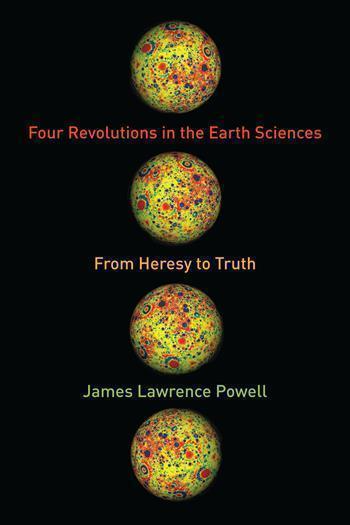
Steven Dutch continues his review of James L. Powell’s Four Revolutions in the Earth Sciences (2015), which began with part 1.
Radiometric dating
In the case of geologic dating, geologists crashed headlong into Lord Kelvin, the leading physicist of the nineteenth century. From 1864 to 1897, Kelvin repeatedly calculated the upper age of Earth and its sun based on the assumptions of a uniform Earth, cooled by conduction with no ongoing heat production, and with the sun getting its energy from gravitational contraction. All of these assumptions, unfortunately, were wrong, but pardonable given the physics of the day. Geologists finally, grudgingly, accepted an age in the tens of millions of years. Ironically, when the discovery of radioactivity reopened the prospect of far greater ages, many geologists responded with a once-bitten twice-shy attitude, like liberated prisoners afraid to leave their unlocked cells. Still, ultimately the geologists had been right and the physicists wrong, and it’s not often you get to stick it to the physicists. The story closes with the tale of Clare Patterson, who found his attempts to measure lead in meteorites confounded by ubiquitous industrial lead contamination, and who ultimately ended up crusading against leaded gasoline. (This story was also told in the rebooted version of Cosmos.)
Plate tectonics
Alfred Wegener was a German meteorologist who observed geological connections between continents and in 1912 proposed that continents had once been joined and drifted apart. As one might expect, the theory wasn’t very well received. Nevertheless, a number of people advocated it and suggested improvements. The crucial evidence was on the sea floor, and when that evidence appeared in the 1960s, the idea of continental drift, and a satisfying explanation of it in the form of plate tectonics, quickly gained general acceptance.
There was a geographic bias in responses to continental drift, mentioned in passing in the book, with Americans most hostile and Europeans less so. For Americans, continental drift was the answer to questions that nobody was asking. Few North American geologists had research interests in the Southern Hemisphere, and a massive ice age in the Southern Hemisphere was hard to reconcile with the warm conditions in North America in the late Paleozoic. But as plate tectonics gained ground, another pattern emerged. Skeptics back-pedaled through geologic time. They admitted that plate tectonics was established for the last 200 million years (when ocean floor data allowed precise plate reconstructions) but not in the Paleozoic, still less in the Precambrian. Some of this response is due to the difficulty of interpreting structures that formed deep within Earth and recognizing their connection to structures seen near the surface. Nowadays plate tectonics is pretty generally accepted back to two billion years ago. Beyond that, the observed structures are hard to relate to more recent ones, and there is a real possibility that a higher heat flow meant that crustal movements were smaller in scale and faster in rate than they were later.
There are myriad incidents that could be added to the story, and Powell cites a number of comprehensive sources for more detail. Three important factors that are mostly omitted from his discussion are the development of World War II technology, the International Geophysical Year of 1957–1958, and the World-Wide Standardized Seismic Network. The book describes sonar and Harry Hess’s naval career, but gives short shrift to the equally important development of sensitive magnetometers, initially for detecting mines and submarines, but vital for mapping the magnetic lineaments on the ocean floors. The IGY saw the first artificial satellites, but also the revelation of the full extent of the mid-ocean ridge system and pioneering work on polar wander. And the Worldwide Standardized Seismic Network, originally for monitoring nuclear testing, brought the seismicity of plate margins into crisp focus. Earthquakes along the Mid-Atlantic Ridge, previously thought to occupy a broad swath, suddenly were realized to occur in a hair-thin band precisely following the medial rift valley and intervening transform faults.
The worst villainy in the opposition to plate tectonics isn’t even mentioned in the book. During the 1970s, one prominent opponent used his position as editor of a major journal to allow other opponents free rein. The resulting articles have to rank among the worst junk ever published in a major scientific journal. I was then a graduate student at Columbia University, home to a lot of researchers who had been instrumental in winning the battle for plate tectonics. Their response was not so much anger as amused, open-mouthed incredulity.
While the opposition to drift was widespread and sometimes pretty nasty, still, advocates of drift did get their papers published. Any scientist who has ever had a paper rejected for being a bit speculative, or been told to reduce a complex discussion to a few pages, can only sob with frustration at Frank Taylor’s getting forty-three pages in the Bulletin of the Geological Society of America in 1910.
Next up in part 3: meteor impact and climate change.
Steven Dutch is Professor Emeritus in the Department of Natural and Applied Sciences (Geoscience), University of Wisconsin–Green Bay, and the coauthor, with Joseph M. Moran and James S. Monroe, of the textbook Earth Science (Belmont [CA]: West/Wadsworth Publishing Company, 1998). He is signatory #424 to Project Steve.
